Stinging Insect Identification
Select an insect below to learn about its nest, aggressiveness and sting pain index, or order copies of our identification poster.
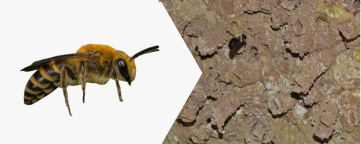
Miner Bee
Andrenid spp.
Description: Less than ½ in. in length; black, sometimes with yellow or cream markings on face, legs and thorax; moderately hairy.
Nest: Ground nests, sometimes in sand or loam, sometimes in lawns.

Aggressiveness: Non-aggressive; do not sting or bite.

Sting Pain Index: N/A
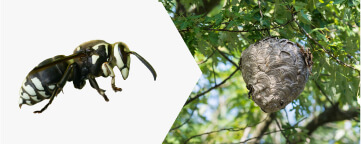
Bald-Faced Hornet
Dolichovespula maculata
Description: Workers ½ – ¾ in. in length; black with white markings on the abdomen, face (hence the common name “bald-faced”).
Nest: Commonly found in tree hollows, trees, dense shrubs, or on structures. Can be large; covered in paper envelope.

Aggressiveness: Highly aggressive, attacking anything close to the nest.

Sting Pain Index: Rich, hearty, slightly crunchy. Similar to getting your hand mashed in a revolving door.
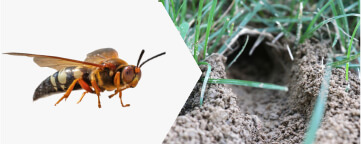
Cicada Killer
Sphecius spp.
Description: Workers are large 1 ½- 1 ⅝ in. in length; wings transparent, russet in color; head and thorax rust or dark brown; abdomen black with yellow bands.
Nest: Burrows are found in well drained, light textured soil, full sunlight; U-shaped trench lead to opening of nest; soil accumulates around entrance during construction.

Aggressiveness: Males are mean, but have no stinger. Females rarely sting unless handled roughly.

Sting Pain Index: Clean. Concentrated dish soap seeps into a freshly cut finger.
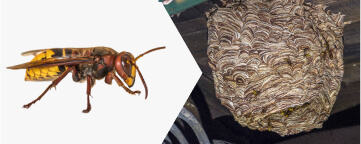
European Hornet
Vespa crabro
Description: Workers up to 1 in. in length; head is red and yellow, thorax is red and brown, abdomen with yellow and brown markings; often mistaken for Eastern cicada killer.
Nest: Large, enveloped paper nests found in protected aerial spots, such as tree hollows, wall voids; subterranean nests occasionally reported.

Aggressiveness: Will fiercely protect nest but not considered aggressive if unprovoked.

Sting Pain Index: About as painful as a honey bee sting.
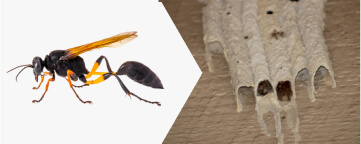
Mud Dauber
Sphecid spp.
Description: Workers ¾ – 1 in. in length; thin, thread-like waist separating abdomen and thorax; typically dark blue or black with yellow or orange markings.
Nest: Short mud tubes constructed side by side attached to walls or other surfaces; approximately 1 in.

Aggressiveness: Do not defend nest, rarely aggressive.

Sting Pain Index: Sharp with a flare of heat. Jalapeño cheese when you were expecting Havarti.
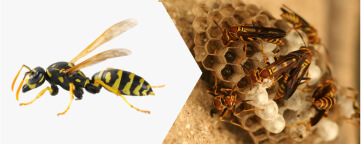
Paper Wasp
Polistes spp.
Description: Workers ⅝ – ¾ in. in length; distinct constricted waist; yellow and black, sometimes brown, red/orange; wings lay longitudinally along the body at rest; legs dangle behind when in flight.
Nest: Typically constructed in protected area such as an overhang on a structure; suspended from a single stalk, often high above the ground; cells exposed (no covering); “inverted umbrella”.

Aggressiveness: Aggressive when nest is threatened—will sometimes give a “warning bump” when intruders get too close; can sting several times; sting creates sharp, burning sensation.

Sting Pain Index: Burning, throbbing, and lonely. A single drop of superheated frying oil landed on your arm.
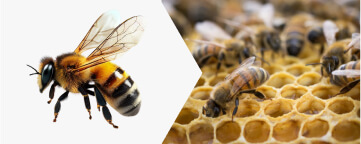
European Honeybee
Apis mellifera
Description: Workers ½ – ⅝ in. in length; black with golden hairs and hairy eyes; long abdomen with black, gold stripes; moderately hairy body.
Nest: Inside tree hollows or other protected structures. No paper coating; distinct honeycomb.

Aggressiveness: Generally not aggressive; will defend nest.

Sting Pain Index: Burning, corrosive, but you can handle it. A flaming match head lands on your arm and is quenched with lye and then with sulfuric acid.
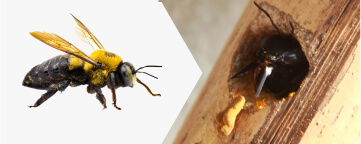
Carpenter Bee
Xylocopa spp.
Description: Workers ¾ – 1 in. in length; similar to bumble bees in appearance but lack hair on abdomens.
Nest: Excavated holes in wood, perfectly round, about the size of your little finger; prefer unpainted, weathered wood; often use softer varieties of wood for nesting sites; typical nesting sites include siding, decks, rafters.

Aggressiveness: Rarely aggressive unless feeling extremely threatened.

Sting Pain Index: Swift, sharp, and decisive. Your fingertip has been slammed by a car door.
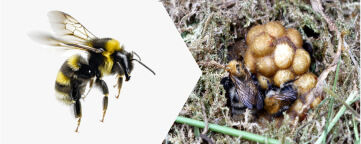
Bumble Bee
Bombus spp.
Description: Workers ¾ – 1 in. in length; black face and top of head; abdomen black and yellow; wings with distinct black band.
Nest: Nests small, appear disordered with cells made from wax; most nests underground, typically in abandoned rodent holes; occasionally found in wall voids; cavity lined with dry grass or moss.

Aggressiveness: Generally not aggressive; will defend nest.

Sting Pain Index: Colorful flames. Fireworks land on your arm.
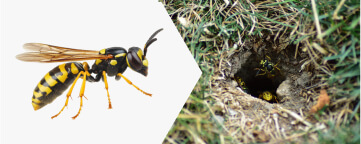
Yellowjacket
Vespula spp.
Description: Workers ½ in. in length; black and yellow markings on dorsum of abdomen; wings lay longitudinally at rest; legs tucked into body in flight.
Nest: Can be large; often underground or in rotting wood; paper/pulp covering when hanging from tree or structure.

Aggressiveness: Will sting several times, often unprovoked.

Sting Pain Index: Hot and smoky, almost irreverent. Imagine W.C. Fields extinguishing a cigar on your tongue.
Pain scale measured using Schmidt sting pain index
